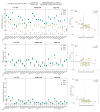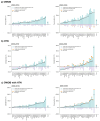Trends and predictions to 2030 in demographic structures and metabolic health for children and adolescents in China: analysis of national school health surveys from 2000 to 2019
- PMID: 40544851
- PMCID: PMC7617964
- DOI: 10.1016/S2352-4642(25)00140-3
Trends and predictions to 2030 in demographic structures and metabolic health for children and adolescents in China: analysis of national school health surveys from 2000 to 2019
Abstract
Background: Understanding the changing metabolic health burden among children and adolescents is crucial for current and future public health resource allocation in China, particularly given rapid population ageing. We aimed to estimate trends in the metabolic burden in children and adolescents aged 7-18 years from 2000 to 2030, using overweight, obesity, and hypertension as proxy indicators.
Methods: We extracted age, sex, height, weight, and blood pressure data for Han children and adolescents aged 7-18 years, as recorded in five cycles of the Chinese National Surveys on Students Constitution and Health in the years 2000, 2005, 2010, 2014, and 2019. We used demographic indicators reported by the Seventh National Population Census in 2020 to represent the demographic situation in 2019 and UN population estimates and projections for China to derive the national age structure from 2000 to 2030. We calculated the 2019 age-standardised prevalence rates of overweight and obesity, hypertension, comorbid overweight and obesity with hypertension, severe obesity, and severe hypertension. Direct standardisation was applied to adjust for the effect of changes in population structures and derive age-specific prevalence estimates from 2000 to 2030. A population development index that captures demographic trends while accounting for the influence of age structure was calculated from birth rate, death rate, and proportions of the population aged 0-14 years and older than 65 years. Correlation coefficients (r) and corresponding p values for the association between the population development index and metabolic burden were calculated with general linear regression models. Multinomial regressions were applied to model age-specific and sex-specific prevalence rates as a function of time. We used decomposition analysis to evaluate the individual contributions of age-specific prevalence, age distribution, and population growth to the net change in case numbers.
Findings: The final analysis of national survey data included 1 106 416 observations. In 2019, the age-standardised prevalence rates were 21·5% (95% CI 21·3-21·7) for overweight and obesity, 16·6% (16·4-16·8) for hypertension, 5·5% (5·4-5·6) for overweight and obesity with hypertension, 1·6% (1·5-1·6) for severe obesity, and 2·1% (2·0-2·2) for severe hypertension. China's population of children and adolescents aged 7-18 years is predicted to decrease from 276 million in 2000 to 181 million in 2030 (-34·4%). Between 2000 and 2030, we estimate increases of 39·0 million (180·6%) cases of overweight and obesity, 7·1 million (131·5%) cases of overweight and obesity with hypertension, 4·3 million (430·0%) cases of severe obesity, and 1·2 million (34·3%) cases of severe hypertension. Between 2000 and 2030, we estimate a slight decrease of 0·3 million (-0·8%) cases of hypertension. A significant negative association between population development index and metabolic burden was observed for 2019 (r=-0·485, p=0·0062) and projected for 2030 (r=-0·417, p=0·020). Decomposition analysis indicated that rising age-specific prevalence is the primary driver of increasing numbers of metabolic cases, partially offset by population decline.
Interpretation: In the context of China's declining youth populations, increases in the prevalence, clinical severity, and absolute case numbers of overweight and obesity with hypertension signal a worsening metabolic health burden. Beyond public health policies to shape healthier lifestyle patterns, enhanced efforts are needed to prepare China's primary health-care system and optimise the allocation of paediatric health-care resources.
Funding: National Key R&D Program of China, National Natural Science Foundation of China, Beijing Natural Science Foundation, Peking University Talent Introduction Program Project, Clinical Medicine Plus X-Young Scholars Project of Peking University, UK Medical Research Council, and the Abdul Latif Jameel Institute for Disease and Emergency Analytics at Imperial College London, funded by a donation from Community Jameel.
Copyright © 2025 Elsevier Ltd. All rights reserved, including those for text and data mining, AI training, and similar technologies.
Conflict of interest statement
Declaration of interests We declare no competing interests.
Figures





Similar articles
-
Global, regional, and national prevalence of adult overweight and obesity, 1990-2021, with forecasts to 2050: a forecasting study for the Global Burden of Disease Study 2021.Lancet. 2025 Mar 8;405(10481):813-838. doi: 10.1016/S0140-6736(25)00355-1. Epub 2025 Mar 3. Lancet. 2025. PMID: 40049186 Free PMC article.
-
Worldwide trends in underweight and obesity from 1990 to 2022: a pooled analysis of 3663 population-representative studies with 222 million children, adolescents, and adults.Lancet. 2024 Mar 16;403(10431):1027-1050. doi: 10.1016/S0140-6736(23)02750-2. Epub 2024 Feb 29. Lancet. 2024. PMID: 38432237 Free PMC article.
-
Increasing Trends of Pediatric Thoracic and Lumbar Spine Fractures in the United States from 2004 to 2023: A 20-year National Injury Review Depicting Shifts in Mechanisms of Injury.Clin Orthop Relat Res. 2025 Feb 25;483(8):1542-1553. doi: 10.1097/CORR.0000000000003421. Clin Orthop Relat Res. 2025. PMID: 40036050
-
Physical activity, diet and other behavioural interventions for improving cognition and school achievement in children and adolescents with obesity or overweight.Cochrane Database Syst Rev. 2018 Mar 2;3(3):CD009728. doi: 10.1002/14651858.CD009728.pub4. Cochrane Database Syst Rev. 2018. PMID: 29499084 Free PMC article.
-
Physical activity, diet and other behavioural interventions for improving cognition and school achievement in children and adolescents with obesity or overweight.Cochrane Database Syst Rev. 2018 Jan 29;1(1):CD009728. doi: 10.1002/14651858.CD009728.pub3. Cochrane Database Syst Rev. 2018. Update in: Cochrane Database Syst Rev. 2018 Mar 02;3:CD009728. doi: 10.1002/14651858.CD009728.pub4. PMID: 29376563 Free PMC article. Updated.
References
-
- The Lancet Diabetes & Endocrinology. Metabolic health: a priority for the post-pandemic era. Lancet Diabetes Endocrinol. 2021;9(4):189. - PubMed
MeSH terms
LinkOut - more resources
Full Text Sources
Medical

